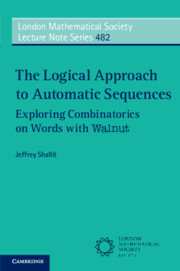Book contents
- Frontmatter
- Contents
- Preface
- Permissions
- 1 Introduction
- 2 Words and sequences
- 3 Number representations and numeration systems
- 4 Automata
- 5 Automatic sequences
- 6 First-order logic and automatic sequences
- 7 Using Walnut
- 8 First-order formulas for fundamental sequence properties
- 9 Regular sequences and enumeration problems
- 10 Synchronized sequences
- 11 Additive number theory
- 12 Paperfolding sequences
- 13 A final word
- Bibliography
- Index
12 - Paperfolding sequences
Published online by Cambridge University Press: 09 September 2022
- Frontmatter
- Contents
- Preface
- Permissions
- 1 Introduction
- 2 Words and sequences
- 3 Number representations and numeration systems
- 4 Automata
- 5 Automatic sequences
- 6 First-order logic and automatic sequences
- 7 Using Walnut
- 8 First-order formulas for fundamental sequence properties
- 9 Regular sequences and enumeration problems
- 10 Synchronized sequences
- 11 Additive number theory
- 12 Paperfolding sequences
- 13 A final word
- Bibliography
- Index
Summary
Up to now our logical formulas have allowed us to state formulas concerning a single automatic sequence, or perhaps two at the same time (as in Section 8.9.3). In some cases, however, it’s possible to use our approach to prove results about infinitely many sequences (even uncountably many sequences) at once!
- Type
- Chapter
- Information
- The Logical Approach to Automatic SequencesExploring Combinatorics on Words with Walnut, pp. 316 - 326Publisher: Cambridge University PressPrint publication year: 2022

